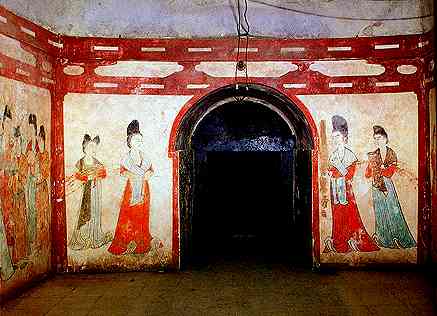Yearning for Immortality
The Silent Army of XianThe fear of death follows from the fear of life. A man who lives fully is prepared to die at any time. - Mark Twain
Source: www.shan.org.hk taken 28 December 1997 by Nasrin Sobhan In historical terms, Xian, once the largest city in the world, is perhaps one of the most fabulous cities in China. For more than 1,000 years until the 10th century AD, this city in east-central China was the capital of 11 dynasties, including the great Ran dynasty and the Tang. It was here that the last Tang emperor dallied with his favorite concubine and almost lost his throne to a rebel general. The infamous Empress Wu ruled from here, and it was to this city that Dowager Empress Ci Xi fled when the European forces entered Beijing to punish the Chinese in the wake of the Boxer Rebellion. Today, Xian is famous for the tomb of Emperor Shih Ruang Ti, the first emperor of China. The burial place is guarded by life-size terra-cotta figures of soldiers, part of an estimated 6,000-member clay army made for the tomb of the emperor. Discovered in 1974, the terra-cotta army was part of the retinue destined to accompany him when he passed on to the other world. So far, three pits have been excavated. There are more than 1,000 soldiers in the pits, some positioned in the traditional square combat formation, others arranged in ranks of four foot soldiers and archers, each with his own uniform, leggings, and jerkin, each with a unique face and expression, all so life-like in their very immobility that they seem ready to move, waiting only for the command.
Source: Travellers' World In other pits are chariots and charioteers, their arms extended as if holding reins, and terra-cotta horses, their mouths open, champing at some invisible bit, their tails bunched and knotted in traditional style. The figures were found in pieces, the weapons looted centuries ago. They have been painstakingly put together again, although the original colours have not been restored. When Shih Ruang Ti came to power in the 3rd century BC, China was a mess of small warring states. By the end of his reign, he had welded the whole country into an empire that extended from the Gobi Desert to the Gulf of Tonkin. Using conscripted labour, he joined the fragmented ramparts of earlier rulers and built the Great Wall of China. The emperor spent years searching for the elixir of life, ultimately dying on one of those endless, fruitless expeditions. All the emperor's concubines were buried with him, as were the workers who built his mausoleum.
Source: www.ifalldown.com The site of the terra-cotta soldiers is only part of the mausoleum. The whole tomb is a marvel of workmanship and imagination. It was a replica of the Qin empire, complete with cities, mountains, and streams controlled by levers that made them flow. The vault was broken into and looted just a few years later, in spite of elaborate security mechanisms that included weapons controlled by machinery that could kill anyone trying to get inside. It would seem that the grave of the emperor itself was not touched, as the seals are still intact. There is much else to see in and around Xian. Among the more famous sites are the Hua Qing hot springs, where the Tang Emperor Ming Hung bathed with his beloved, and also the site of the famous "Xian Incident," when Chinese nationalist leader Chiang Kai-shek was kidnapped one morning in 1936 when China was trying to fend off the Japanese. The 7th-century Great Mosque of Xian is a splendid example of Ming Muslim architecture. The buildings are made in the Chinese style, with curved roofs and upturned eaves. The gray brick buildings are constructed around a series of spacious inner courts. In the courtyards are archways decorated with floral stonework and Arabic calligraphy, red-pillared pavilions, and stone tablets with Arabic inscriptions. The peacock-blue roof is pure Chinese, however.
In the narrow lane leading up to the mosque, local merchants have set up a bazaar. The stalls are packed with a selection of eggshell porcelain, jade, cloisonné, and a variety of other handicrafts. In the evening, travellers can visit the food street near the Xian Hotel. Low tables and chairs are put out, and kebab sellers set up stalls where one can buy barbecued mutton and roast chicken with the local bread and some salad. The hotels and restaurants serve excellent food. At one meal was served, among other items, ox-tongue soup, bamboo shoots, and a pudding made out of black rice, which in the old days was reserved for the emperor and his family. A flight of an hour and 10 minutes from Beijing will bring the traveller to Xian, a must on any visit to China. Source: World Press Review October 1991 originally appearing in the weekly Dialogue of Dacca, Bangladesh
Qianling TombAbout 80 kilometers west of Xi'an situated on Liangshan Hill, Qianling was the joint tomb of Emperor Tang Gaozong (Li Zhi, 628AD - 683AD) and Empress Wu Zetian (624AD - 705AD), the only Empress in Chinese history. Qianling Tomb was built in 684AD. According to the records, the inner city, about 240 square metres, followed the rectangular layout of Chang'an city with the gates on the four sides named: the Phoenix (south gate), the Tortoise (north), the Black Dragon (east) and the White Tiger (west). The city comprises the inner city and the outer. Many splendid buildings such as dedicatory halls and gate towers were built. Stone Carvings
Source: chinaetravel.com If you stand at the southern approach to the mausoleum you can appreciate the original Tang layout and design. If you start from the southern approach, which is between two prominent small hills, an avenue lined by animal and human statues leading all the way to the tombs is Qianling's most impressive feature, creating an awe-inspiring effect. From a distance, the hills greatly resemble a pair of women's breasts, reinforcing the tale that Emperor Tang Gaozong had them constructed to honor the natural beauty of his wife. If you follow the avenue you will see closely these exquisite carvings of the Tang. First there comes two winged horses galloping, and then two vermilion birds like ostriches. Five pairs of saddled horses come next, each with a groom. After that, the most noteworthy is 10 pairs of guardian generals with very large heads, wearing long-sleeved robes and holding the hilts of long swords. Qijie Bei (Tablet of Seven Elements)A tablet to the west of the Phoenix Gate consists of seven joints, which symbolise the Seven Elements (the seven essences of the world) - the Sun, the Moon, Metal, Wood, Water, Earth, and Fire. The tablet is 6.3 metres high, 1.86 metres wide and 61.6 tonnes weight, and was built to record Gaozong's political achievements and military exploits. The pedestal was engraved with animal figures. The inscription was written by Emperor Zhongzong and composed by Emperor Wu Zetian. The gold filled characters can still be discerned today. Blank TabletTo the east of the Phoenix Gate is the Blank Tablet 6.3 metres high, and 98.9 tonnes weight. The sides of the tablet were carved with figures of dragon. On the top part of the tablet were carved eight oysters intersecting each other. Placing a tablet with no word, before an emperor's mausoleum, has never been found before in China. 61 Kings
The tombs is large in scope with a circumference of 40 kilometres, and 17 satellite tombs of princes, kings and high ministers such as the Tomb of Crown Prince Zhanghuai, the Tomb of Crown Yide and the Tomb of Princess Yongtai. Tomb of Crown Prince ZhanghuaiSimilar to the Tomb of Princess Yongtai, the Tomb of Prince Zhanghuai also has tunnels, tomb chambers, and a collection of buried articles. Prince Zhanghuai's DeathPrince Zhanghuai - Li Xian, the second son of Emperor Gaozong and Empress Wu Zetian - was comparatively talented among Gaozong's children. Li Xian once summoned famous scholars to annotate The Historical Records of the Later Han Dynasty. The book referred to the historical fact that Lu Hou, wife of Emperor Gaozu, founder of the Han dynasty, pushed out courtiers and usurped the supreme power of the court after her husband's death. Wu Zetian thought that Li Xian's action in producing this book was a taunt of her and tried to persecute him. Later when she discovered weapons hidden in the Easter Palace where Li Xian lived, Empress Wu deprived him of the title of crown prince and exiled him to Bazhou (present-day Bazhong County, in Sichuan province), on the pretext that he had hidden weapons secretly and plotted a rebellion. In 648AD, Li Xian died mysteriously in Bazhou at the age of 31. His remains were buried near Qianling. In 706AD, after Wu Zetian's death, Li Xian was awarded the title of Crown Prince Zhanghuai. The structure of the tomb is basically the same as that of Princess Yongtai, only a bit smaller in scale. The tomb consists of a long, sloping tomb tunnel, 71 metres long, 3.3 metres wide and 7 metres high, four skylights, six niches, a brick corridor, an antechamber and a burial chamber. Over 600 articles have been unearthed, with ceramic and tri-color figurines and burial articles being most impressive. The life-like sand warrior figures one metre high are also noteworthy. Fifty murals in the tomb remain basically intact. Among these, the charming paintings of Courtiers and Foreign Envoys, Hunting Procession, Polo Game and Watching Birds and Catching Cicadas, demonstrate the superb artistic achievements of the Tang dynasty.
Tomb of Crown Prince YideLying to the southeast of Qianling is the tomb of Prince Yide - the first son of Emperor Zhongzong. He died in 701AD when he was only 19 years old. In 705, when Zhongzong returned to the throne, Prince Yide was awarded posthumously the title of Crown Prince Yide and in 706 his remains were moved to the Qianling. A mound and walls surround the tomb of Prince Yide enclosing it in a rectangle. To the south of the walls was a pair of stone lions, stone figures (one was destroyed and only the pedestal remains), and a pair of obelisks (destroyed and buried in the earth when they collapsed). The tomb consists of a tomb tunnel, three doors, seven air-shafts, eight niches, and tomb chambers. It is altogether 10.8 metres in length. Over 40 impressive well-preserved mural paintings in the tomb depict court life including guards of honor, the Blue Dragon, White Tiger, city walls, watch towers, musicians, men-servants and maids of honor showing Li Chongrun's special identity. For example, in the Tomb of Princess Yongtai are 12 painted halberds; the Tomb of Prince Zhanghuai has 14, while there are 48 in an emperor's mausoleum. The paintings of Eagle Out For Hunting, Maids of Honor, and Display of Halberds are rich in color and design, making them a feast for the eyes. The carved sketches on the stone outer coffin are fine and smooth and they give a good expression to the features of the Tang-style carved sketches: smooth, clear and powerful. More than 1,000 pieces of historical relics have been unearthed from the Tomb of Crown Prince Yide, including pottery figure, tri-color glazed figures, other earthen wares, as well as gold, bronze and iron wares. Tomb of Princess YongtaiThis was the first tomb to be excavated and remains the most impressive of all the satellite tombs in Qianling. Princess Yongtai was the granddaughter of Tang Emperor Gaozong and his wife Empress Wu Zetian. Her husband was Wu Yanji, son of Wu Chengsi, who was Wu Zetian's nephew. Princess Yongtai was well-known for helping people. There are many stories told locally about how Princess Yongtai had achieved high status in her qigong and martial arts practice. In 701, Princess Yongtai died in Luoyang, at the age of 17. The epitaph suggests that she died in childbirth, however the real reason was considered a mystery. (Supposedly both she and her husband were poisoned by her grandmother after Yongtai revealed secrets about the older woman's affairs with two lovers.) She died in Luoyang, but her father missed her and had her body moved to this tomb outside Xi'an where he lived - after Wu Zetian had died. This was in 705AD: the Emperor Zhongzong gave orders that his daughter and her husband should be buried together in the Qianling Tomb.
Entrance to Princess Yongtai's tomb chamber at Qian Long In front of the Tomb of Princess Yongtai the road is lined with a pair of stone lions, two pairs of stone figures, and a pair of obelisks (ornamental stone columns). The tomb is pyramid-shaped, 87.5 metres long and 3.9 metres wide with a chamber 16.7 metres deep. A tunnel leads to the tomb with charming murals on the walls. They represent court attendants, almost all of them women, wearing the elegant central Asian fashions of the day. On the walls are six small niches in which a multitude of tri-color glazed pottery figures, poetry and porcelain wares were placed. The burial chamber represents the house where Princess lived. The TombAbout 1,000 valuable cultural artifacts found in the tomb include murals, pottery and wooden figurines, tri-colour glazed pottery figurines, gold vessels, jade articles, and copper wares. The glazed tri-colour pottery figurines demonstrate the high artistic achievements of the Tang dynasty. The antechamber represents a drawing room with murals mainly depicting elegantly dressed women attendants. You cannot find two identical in facial expression. Some appear to be whispering, others are nodding. On the ceiling of the chamber are painted celestial figures of a triple-leg rooster symbolising the sun, and a Jade Hare representing the moon, with the Milky Way in between. It reveals the development of astronomy at that time. In the rear chamber are the stone coffins of Princess Yongtai and her husband. The coffins had an outer case holding an inner case. The outer palace-like coffin was beautifully engraved with exquisite figures, birds and flowers, with a lady on each side. The inner wooden coffin has completely rotted away due to its long-time saturation in silt. However, some archaeologists suspect that the princess's actual remains were buried secretly nearby. Source: travelchinaguide.com
Ozymandiasby Percy Bysshe Shelley I met a traveller from an antique land Source: Memory
Does Thine Image Die with Thee?by Cody Hatch Is immortality possible? Despite great accomplishments by the paramount influential leaders of any era, sooner or later their legacies seem to be swallowed by history. Events occur in irreversible succession. Anything built eventually crumbles; deeds fade and are forgotten. Nevertheless, a single powerful person can initiate vast changes, leave grand monuments, and be remembered for millennia. This, then, must be the measure of earthly human immortality. The Egyptian Pharaoh Ramses II, known as Ramses the Great, was arguably the most influential pharaoh of the New Kingdom of Egypt; for a monarch such as he, success was measured in military victories, numbers of offspring, and monument building. Since Ramses excelled in each of these categories and left an enduring mark, in so doing, he achieved a measure of immortality. Ramses was an excellent and relentless propagandist who counted battles fought by earlier pharaohs and his own defeats as stunning victories. In addition, he had many victories of his own, including battles against the Libyans, Syrians, Nubians (who were reduced to a de facto province of Egypt during his reign), and, most famously, the Hittites. Indeed, Ramses’ descriptive title "the Great" came from an early victory over the Hittites at Kadesh. Later battles eventually concluded with history’s first peace treaty, between Egypt and the Hittite Empire. This treaty contributed to several decades of peace and prosperity. Under Ramses’ leadership, the slow contraction of Egypt’s borders was reversed and almost all territory held at the height of Egyptian power was regained. These military victories spread Ramses’ fame widely throughout the ancient world. Though military victories were considered an important measure of success for the pharaohs of Egypt, royal fertility was nearly as important. Infant mortality rates were estimated at 33% in the population in general. In addition, the extremely high prevalence of inbreeding among the royal family is thought to have contributed to a marked incidence of birth defects and congenital illnesses. These factors made it difficult for many pharaohs to produce an heir, a vital step for continuation of the dynasty. When Ramses died at the age of 92, he had outlived many of his children and even some of his grandchildren. He was succeeded by his 13th son, the oldest surviving male heir at the time of his death. In such a climate, any pharaoh that could produce many children was justifiably proud of that fact, and was accorded great respect. Ramses’ children are featured on dozens of monuments and temple walls throughout Egypt. It is generally agreed that at least 30 sons of principle wives survived to adulthood. Given that Ramses likely had approximately as many daughters as sons, had wives who produced stillbirths, had children who died as adolescents or earlier, and had uncounted children by lesser wives, it is estimated that, all told, he fathered perhaps 200 children. This is an impressive number by any standard and would mean his descendants comprise a notable portion of the current world population. Finally, Ramses built dozens of monuments to memorialize his victories and his family. Many famous and beautiful tombs, temples, and monuments that have survived to this day date back to his rule, including the tomb of his favorite wife, Nefertari, temples at Abu Simbel, additions to the Luxor and Karnak Temples, and most famously, the Ramesseum (Ramses’ mortuary temple). Indeed, a broken colossus which stood in front of that temple inspired the poem Ozymandias (Ramses’ reign name Usermaatra was Hellenized as Ozymandias), by Percy Bysshe Shelley, who used it as an example of the ultimate futility of all human endeavour. But was Shelley’s choice a good example? The statue in question was not destroyed by the ravages of time, but was instead defaced by 5th century monks. Ramses’ mortuary temple has lasted well over 3,000 years and is a famous, and still substantial, structure today. Even Ramses’ mummified body still exists and has been exhibited on tours which have spanned the globe. Many Egyptologists assert that Ramses placed the indelible stamp of his personality upon modern-day Egypt. Further, many Egyptian citizens carry his genes. Certainly no earlier rulers, and few later ones, have left as large a legacy. That Shelley, 3,000 years later, could even choose one of Ramses’s works as an example for his poem, argues against the poem’s basic premise. If any measure of earthly immortality can be said to be attainable, then Ramses should be said to have achieved it.
For articles related to ageing, including feats that can be accomplished, and a non-spiritual look at what happens after death - funerals, jerky, popsicles, fertiliser, ashes, orbit or dust - click the
"Up" button below to take you to the Index page for this Older and Under section. |
 Animals
Animals Animation
Animation Art of Playing Cards
Art of Playing Cards Drugs
Drugs Education
Education Environment
Environment Flying
Flying History
History Humour
Humour Immigration
Immigration Info/Tech
Info/Tech Intellectual/Entertaining
Intellectual/Entertaining Lifestyles
Lifestyles Men
Men Money/Politics/Law
Money/Politics/Law New Jersey
New Jersey Odds and Oddities
Odds and Oddities Older & Under
Older & Under Photography
Photography Prisons
Prisons Relationships
Relationships Science
Science Social/Cultural
Social/Cultural Terrorism
Terrorism Wellington
Wellington Working
Working Zero Return Investment
Zero Return Investment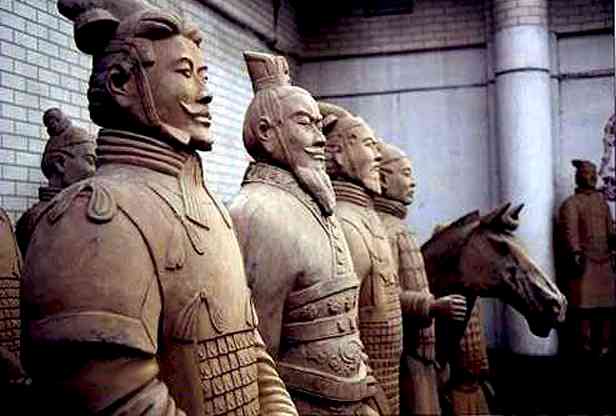

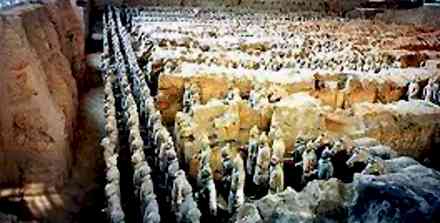
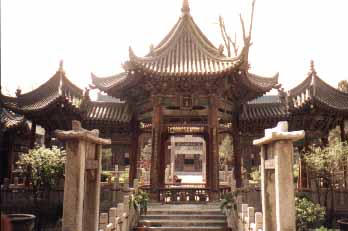
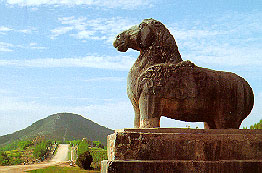
 North of the two ruined towers is a remarkable collection of 61 stone figures, now headless. The inscriptions on the backs
of these figures present that they are actual foreigners who came to the Chinese court in the 7th century for Tang Gaozong's funeral. Some were envoys of central Asian countries and others were barbarian
chiefs. It appears that during the Tang, China had close relationship with neighbourhood countries. Dressed in close-sleeved clothes, wide belts round their waists and boots on their feet, the
figures praying with hands cupped before their chests obviously appear exotic features. Their faces feature high noses and deep-set eyes. The inscriptions on the back are unrecognisable due to
weathering. Only two can be discerned coming from Iran and Afghanistan.
North of the two ruined towers is a remarkable collection of 61 stone figures, now headless. The inscriptions on the backs
of these figures present that they are actual foreigners who came to the Chinese court in the 7th century for Tang Gaozong's funeral. Some were envoys of central Asian countries and others were barbarian
chiefs. It appears that during the Tang, China had close relationship with neighbourhood countries. Dressed in close-sleeved clothes, wide belts round their waists and boots on their feet, the
figures praying with hands cupped before their chests obviously appear exotic features. Their faces feature high noses and deep-set eyes. The inscriptions on the back are unrecognisable due to
weathering. Only two can be discerned coming from Iran and Afghanistan.